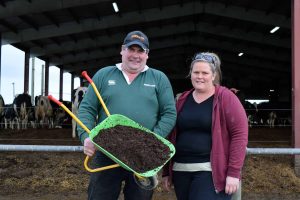
Adapting to those new regulations does not appear to have caused a reduction in graziers for the coming winter, but an Invercargill farm consultant warns that may not be the case in future, as they will require resource consent and face more stringent conditions.
“In the medium to long-term there is going to be pressure on dairy winter grazing,” AgriBusiness Ltd farm management consultant Deane Carson said.
The regulations were announced in September and some of the winter grazing policies have already been reviewed by a government-appointed working group which made recommendations prior to Christmas.
A government spokesperson says ministers have welcomed the group’s report and are awaiting further advice from officials, which will be considered early this year.
Carson says it was too early to accurately quantify dairy cow wintering costs for the coming year, but farming leaders have heard of increases for the coming winter of up to $1.50 per cow per week.
Otago Federated Farmers dairy section chair Luke Kane says he has heard some graziers were increasing prices in part to reflect tougher rules for intensive winter grazing.
He has not heard of any exodus of graziers.
Hadleigh Germann, his Southland counterpart, agreed saying higher grazing costs reflected uncertainty and the perceived costs of meeting new freshwater regulations.
“That whole space is quite frustrating,” Germann said.
Some of the high fees were to fund portable water troughs and back fencing on grazed crops.
Germann says some dairy farmers are looking to exploit a loophole in the regulations that allow cows to be intensively grazed on pasture with baleage and silage.
Regulations as they are currently written exclude the pugging rules on pasture that apply to crops, but the Government has said it will plug that loophole.
Carson is aware of many farmers experimenting with crops and feeding systems to try and adhere to the regulations and avoid the need for resource consent.
“They are trying to find better ways using a bit of theory and logic,” he said.
Carson says the higher regulatory threshold means fewer landowners will be able to provide dairy support in the future.
“The pathway is extremely difficult given the regulatory threshold,” he said.
“It is a matter of time before pressure will come on to the dairy support.”
A wet summer means crop yields were looking exceptionally good and he did not expect there to be any feed shortage.
Meanwhile, the Government is still to announce its response to recommendations from the intensive winter grazing working group convened last year to make the implementation of its policies workable.
In its report released prior to Christmas, the group recommended the removal of pugging and replanting date conditions and instead identifying and protecting critical source areas such as swales or gullies where runoff accumulates prior to entering waterways.
The group also recommended changes to the slope rule, including removing the requirement to determine the mean slope of a paddock and replacing it with a specific maximum slope of 15 degrees.
It also wants an interim approach to the certified freshwater farm plan introduced, what it calls an Intensive Winter Grazing Module, which would make winter grazing a permitted activity if the farmer is undertaking best practice.

























